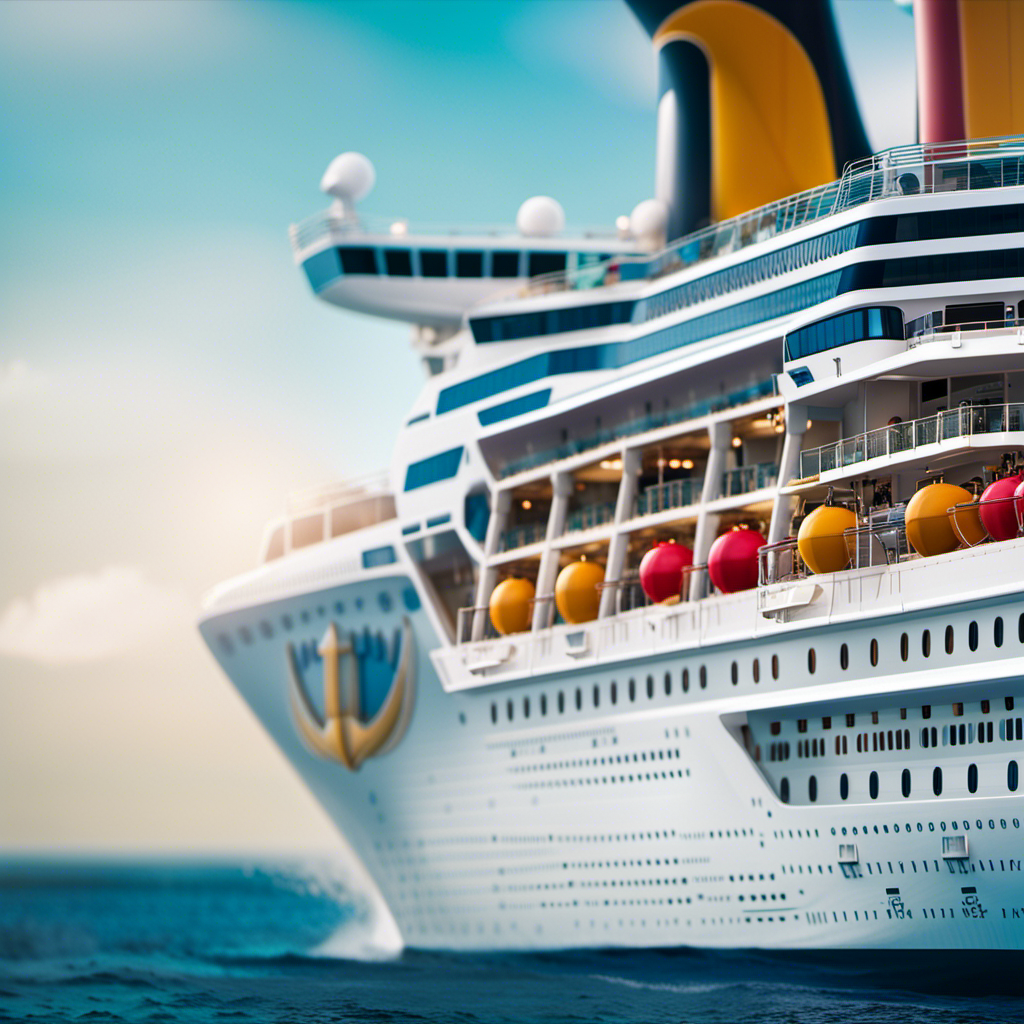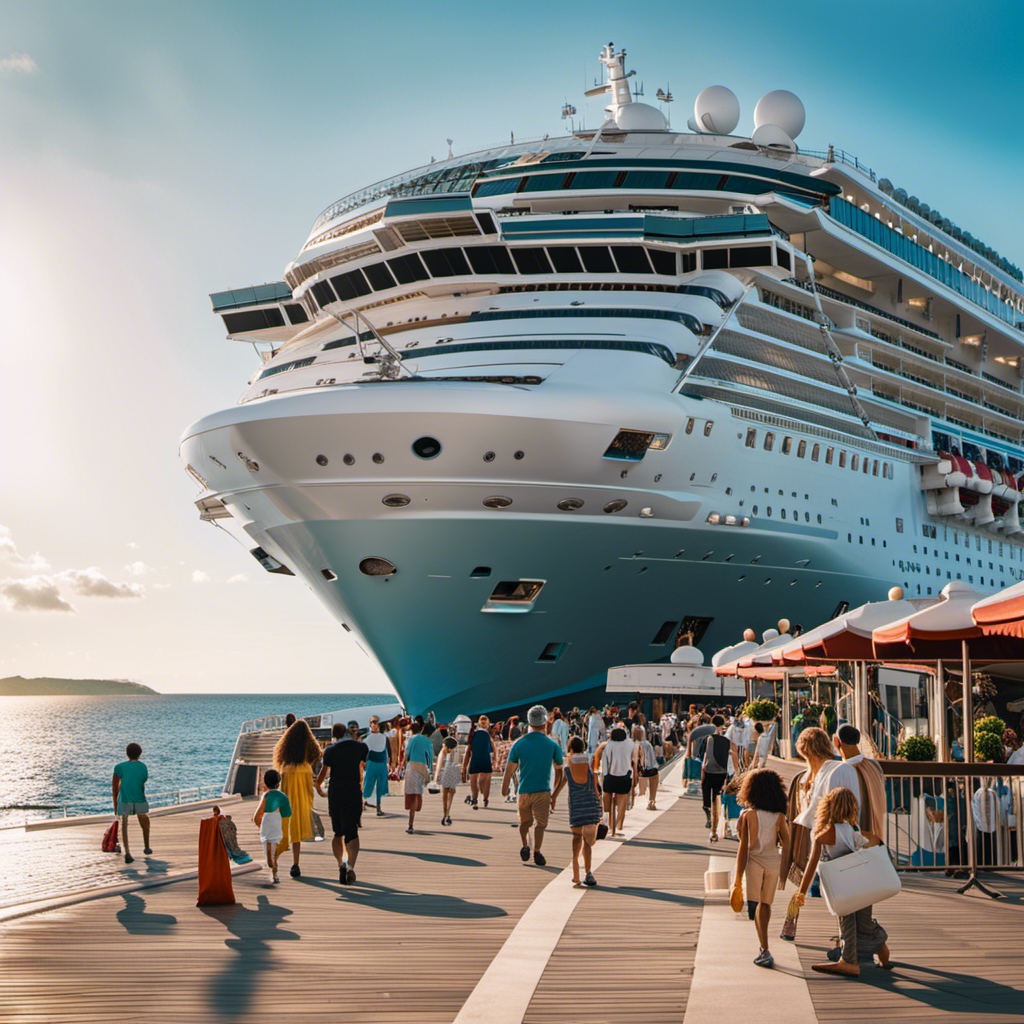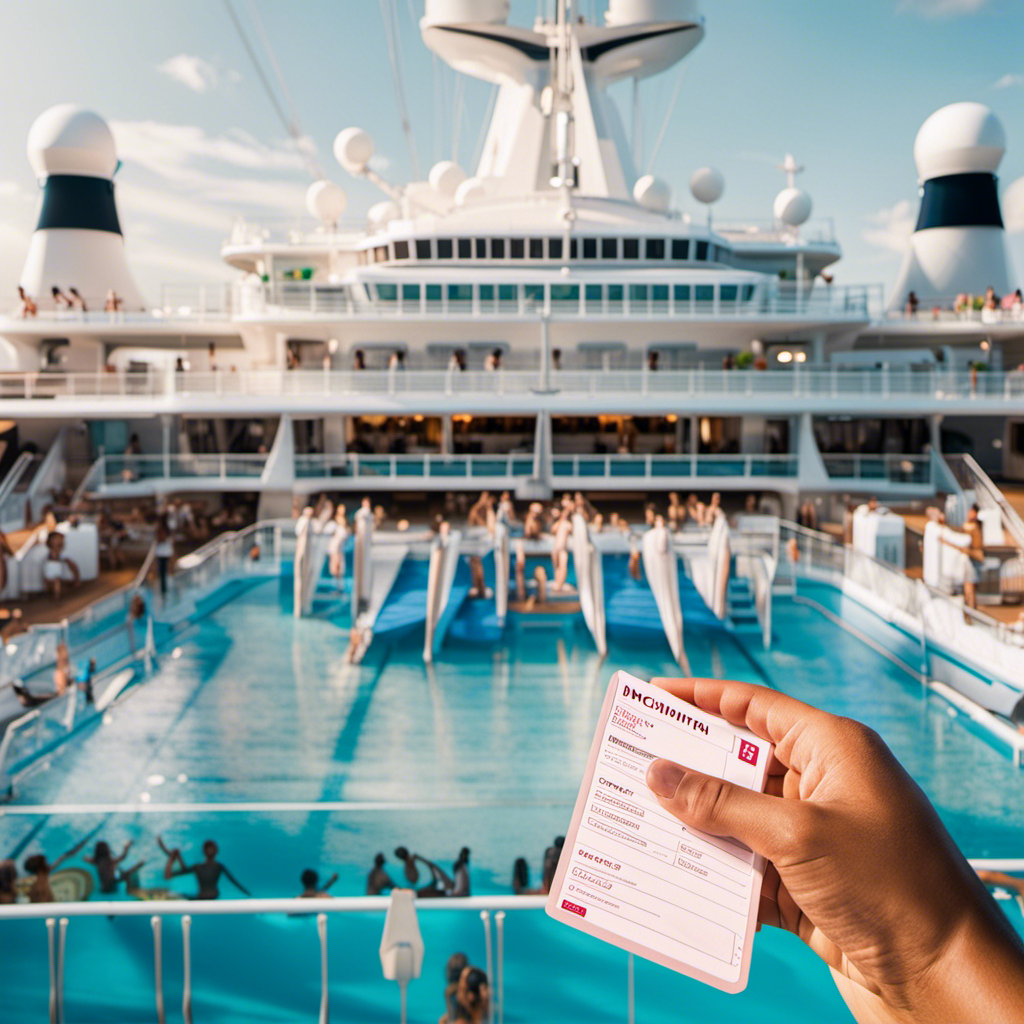While delving into the latest updates regarding cruise ship health from the CDC, I’m struck by the crucial role that mitigation strategies and vaccination endeavors play. The newest data reveals that nearly a third of the vessels that have made reports have encountered possible or verified occurrences of COVID-19.
The CDC employs a color-coded system to assess ship health, with alarming numbers of vessels falling into the orange or yellow category. To combat the risks, cruise lines have implemented measures like mandatory vaccinations and frequent testing.
The CDC emphasizes the importance of vaccination in safeguarding passenger health.
Key Takeaways
- CDC updates a color-coded system for cruise ships based on health status, with green indicating no reports of COVID-19 or COVID-19-like illness for seven days and on-time daily reports to the CDC.
- Three out of four ships sailing with passengers have orange or yellow status, indicating the presence of COVID-19 cases or delayed reports.
- Cruise lines have implemented mitigation measures such as requiring vaccinations for most passengers, frequent testing of crew and unvaccinated passengers, and protocols to limit the spread of COVID-19.
- The CDC believes that cruising can resume safely with thorough protocols and vaccination requirements, as vaccines are the most important tool to keep passengers healthy and improve outcomes if they fall ill with COVID-19.
Current CDC Color-Coded System for Cruise Ship Health Status
The CDC’s current color-coded system for cruise ship health status is crucial in assessing the risk level on cruise ships and implementing appropriate mitigation measures. This system determines whether a ship has possible COVID cases or delayed reports. The color status is based on the ship’s health data from the previous 7 days.
- Green status indicates no reports of COVID-19 or COVID-19-like illness and timely reporting to the CDC.
- Orange status means COVID-19 cases have been reported but are below the investigation threshold.
- Yellow status indicates the ship meets the investigation threshold and has delayed reporting.
- Red status signifies sustained transmission or potential overwhelming of medical resources, and missed reports.
Cruise lines face challenges in implementing testing protocols, contact tracing, and ensuring passenger and crew vaccination. Vaccines play a crucial role in preventing and controlling outbreaks on cruise ships. Vaccinated individuals have better outcomes if they contract COVID-19, but cases may still occur due to testing and transmissible variants.
Criteria for Green Ship Status
Based on the criteria, if a ship has no reports of COVID-19 or COVID-19-like illness for seven days and submits daily reports on-time, it can achieve green status. This indicates that the ship has effectively implemented mitigation measures to prevent the spread of the virus.
The effectiveness of these measures is evident in the fact that only a small percentage of cruise ships have achieved green status. Three out of four ships sailing with passengers have orange or yellow status, suggesting that there have been recent cases reported or delayed reports.
This highlights the importance of adhering to the protocols put in place by cruise lines and the CDC to limit the spread of COVID-19. Vaccinations play a crucial role in these efforts, as they are the most important tool to keep passengers healthy and minimize the impact of any potential outbreaks.
Criteria for Orange Ship Status
According to the criteria, if a ship has reported COVID-19 in the past seven days and is below the CDC’s investigation threshold, it receives orange status. This means that there have been recent cases of COVID-19 on the ship, but it does not meet the threshold for a full investigation by the CDC.
The CDC’s color-coded system is designed to provide an indication of the health status of cruise ships based on surveillance data from the previous week. The orange status serves as a warning that there have been cases on the ship, but further investigation may not be necessary.
It is important for passengers and crew on these ships to follow mitigation measures and protocols to prevent the spread of the virus.
Criteria for Yellow Ship Status
I learned that a ship receives yellow status if it meets or exceeds the CDC’s investigation threshold for COVID-19 cases and fails to submit one or more daily reports on time. This yellow ship status criteria has a significant impact on cruise operations. It indicates that there are possible cases on board and a delay in reporting, which raises concerns about the health and safety of passengers and crew. The table below provides a summary of the criteria for yellow ship status:
| Yellow Ship Criteria |
|---|
| Ship meets or exceeds CDC’s investigation threshold |
| Ship fails to submit one or more daily reports on time |
When a ship is designated as yellow, it signifies a potential outbreak and the need for further investigation and intervention. Cruise lines must take immediate action to mitigate the spread of COVID-19, such as implementing enhanced cleaning protocols, isolating and testing individuals with symptoms, and conducting contact tracing. Additionally, passengers and crew may face additional restrictions and testing requirements, impacting their overall cruise experience. It is crucial for cruise lines to prioritize the health and safety of everyone on board and comply with the CDC’s guidelines to prevent further transmission of the virus.
Criteria for Red Ship Status
When a ship reaches red status, it indicates sustained transmission of COVID-19 illness or potential for overwhelming medical resources. This designation has significant effects on the ship and its passengers. Here are some key points to consider:
-
Contact tracing challenges: Due to the close quarters and large number of people on a cruise ship, contact tracing becomes extremely difficult. Identifying and tracking potential contacts of infected individuals becomes a complex task, further exacerbating the spread of the virus.
-
Isolation and quarantine: Red ship status often results in the need for isolation and quarantine measures. Infected individuals and their close contacts may need to be isolated in cabins or designated areas, leading to disruptions in passengers’ travel plans and limited access to amenities.
-
Medical resource strain: Red status indicates a potential overwhelming of medical resources onboard the ship. Limited medical facilities and staff may struggle to handle the increasing number of COVID-19 cases, potentially compromising the quality of care provided.
Navigating the challenges of contact tracing and managing the effects of red ship status remains a critical task for cruise lines and health authorities to ensure the safety and well-being of passengers and crew.
Status of Ships Sailing With Passengers
Passenger confidence in cruise travel has been significantly impacted by the COVID-19 pandemic. The status of ships sailing with passengers reflects this concern.
According to the CDC, three out of four ships currently sailing with passengers have orange or yellow status, indicating the presence of COVID-19 cases or delayed reports. This data raises questions about the effectiveness of mitigation measures implemented by cruise lines and the overall safety of cruise travel.
The cruise industry has taken steps to address these concerns by requiring vaccinations for most passengers and implementing frequent testing protocols. However, outbreaks of cases on ships, albeit smaller than at the start of the pandemic, continue to occur.
To restore passenger confidence, it is crucial for cruise lines to demonstrate their commitment to the health and well-being of their passengers through strict adherence to protocols and the prioritization of passenger safety.
Mitigation Measures by Cruise Lines and CDC
Frequent testing protocols and vaccination requirements have been implemented by cruise lines to limit the spread of COVID-19 on board ships. These measures are crucial to ensuring the safety of passengers and crew amidst the ongoing pandemic.
The importance of testing cannot be overstated, as it allows for the early detection and isolation of cases, preventing further transmission. By requiring vaccinations, cruise lines are further reducing the risk of infection and creating a safer environment for everyone on board.
These mitigation measures have had a significant impact on the cruise industry, as outbreaks of cases on ships have been relatively small compared to the early stages of the pandemic. The protocols put in place by cruise lines and the CDC are instrumental in limiting the spread of COVID-19 and instilling confidence in travelers.
The industry continues to face unique challenges, but the implementation of testing and vaccination requirements is a crucial step towards a safer cruising experience.
CDC’s Stance on Cruising and Importance of Vaccines
Implementing thorough protocols and requiring vaccinations are crucial steps in ensuring the safety of individuals and resuming cruises with confidence. The CDC believes that cruising can resume safely with these measures in place. Vaccines are considered the most important tool in keeping passengers healthy on board. Cruise lines have implemented vaccination requirements for most passengers, along with frequent testing for crew, unvaccinated passengers, and suspected cases. It is important to note that cruising is not a zero-risk activity, but the CDC recommends that unvaccinated individuals should not sail. Despite the protocols in place, cases may still appear on ships due to testing and the presence of transmissible variants. However, vaccinated individuals have better outcomes if they fall ill with COVID-19. Reopening cruises with vaccination requirements is a key aspect of ensuring the safety of passengers and resuming normal operations.
| Keywords: | Reopening cruises | Vaccination requirements for cruising |
|---|---|---|
| CDC’s Stance | Cruising can resume safely with thorough protocols | Vaccines are the most important tool for keeping passengers healthy |
| Cruise Line Measures | Implementing vaccination requirements and frequent testing | Protocols put in place by cruise lines and CDC are important to limit spread |
| Risk Assessment | Cruising is not a zero-risk activity | Unvaccinated individuals should not sail |
Frequently Asked Questions
How Many Cruise Ships Reported Possible or Confirmed COVID-19 Cases in the Past Week?
In the past week, there were 17 cruise ships with possible or confirmed COVID-19 cases. This accounts for about 27% of the 62 ships reporting data to the CDC.
What Percentage of the Total Number of Cruise Ships Reporting Data to the CDC Had Possible or Confirmed COVID-19 Cases?
Approximately 27% of the cruise ships reporting data to the CDC had possible or confirmed COVID-19 cases in the past week. Mitigation strategies and vaccination requirements are important in preventing the spread of the virus on cruise ships.
How Does the CDC Determine the Color Status of a Cruise Ship?
The CDC determines the color status of a cruise ship based on surveillance data from the previous 7 days. Factors like COVID-19 reports, timeliness of daily reports, and investigation thresholds determine if a ship is green, orange, yellow, or red.
What Criteria Must Be Met for a Cruise Ship to Be Classified as a "Green Ship"?
To be classified as a "green ship," a cruise ship must have no reports of COVID-19 or COVID-19-like illness for seven days and must submit on-time daily reports to the CDC.
How Many Ships Sailing With Passengers Have Orange or Yellow Status?
Three out of four ships sailing with passengers have orange or yellow status. This suggests that a significant percentage of vaccinated passengers are still at risk, impacting the travel industry’s recovery.










